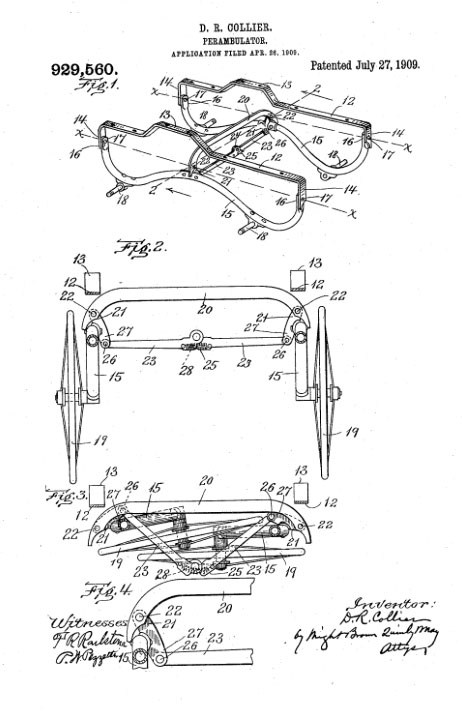

Patented July-27, 1909: Be it known that I, DAVID R. COLLIER of Gardner, in the county of Norcester and State of Massachusetts, have invented certain new and useful Improvements in Perambulators, of which the following is a specification.
This invention relates to childrens carriages or perambulators, adapted to be folded into compact form for storage or shipment, and particularly to a carriage of this character of the type shown in Letters Patent of the United States, No. 862,711, granted to me August 6, 1907. In said patented carriage, the body is supported by longitudinal side bars to which are hinged longitudinally extending wheel frames provided with axle arms on which the wheels are mounted, the said wheel frames being adapted to swing inwardly under the body of the carriage to retract the wheels when the carriage is folded, and to be swung outwardly to project the wheels when the carriage is in its operative condition.
The present invention has for its object to provide improved means for rigidly supporting the wheel frames against lateral or swinging movements when the carriage is in its operative adjustment, the means being of such character that they permit the ready swinging of the frames for the purpose of retracting and projecting the wheels.
Known as ‘Chair City’ and the ‘Furniture Capital of New England,’ Gardner, Massachusetts, had a long and important history in furniture production, tracing its origins to 1826, when five brothers in the Heywood family began to build furniture in a barn near their father’s farm. The firm grew steadily, and in 1897 became one of the largest in the country when it merged with Cyrus Wakefield’s flourishing wicker furniture operation in South Reading (now Wakefield).
Gardner was also the home of many other manufacturers, including the Conant-Ball furniture factory and the Nichols & Stone Chair Company, which moved to Gardner at the turn of the twentieth century and flourished for a hundred years. By 1910 Gardner boasted some twenty chair factories which produced four million chairs per year, making it at that time the eastern equivalent to Grand Rapids, Michigan. A spin-off of the chair industry was perambulators and strollers. Collier Keyworth entered this trade early, registering patents for improvements to protect their own models. David R Collier patented improvements for perambulators in 1909 and for chairs in 1919.
O.W. Siebert Mfg. Co was a neighbouring manufacturer of baby carriages; apparently the company started in 1898. I’ve not yet seen any documentary evidence of when they started making children’s tricycles but by the 1930s they were a regular manufacturer.
This tricycle was badged by Collier-Keyworth; O.W Siebert badged the same tricycle as the Arrowcycle. It’s not known which of these two companies actually manufactured it. But it was common practise for local companies to share manufacturing processes and distribution networks.

1927 Collier-Keyworth ‘C-K Cycle’
Chain-drive Tricycle
Frame 14.5″
Wheels 16″
LENGTH: 39″
WIDTH: 16″
HEIGHT: 32″





UHLEN CARRIAGE CO CATALOGUE EXTRACT
Uhlen Carriage Co, of Rochester, NY, was in a similar business to both Collier-Keyworth and Siebert, primarily selling baby carriages. The Arrowcycle appears in their 1927 catalogue, below.


















C-K CYCLE: UNDERSIDE










SEIBERT ARROWCYCLE FOR COMPARISON




































